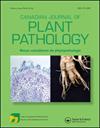二行春大麦(Hordeum vulgare L.)对赤霉病(Fusarium graminearum Schwabe)和脱氧雪腐镰刀菌醇产生差异反应的遗传结构和全基因组关联研究
IF 1.5
4区 农林科学
Q3 PLANT SCIENCES
引用次数: 1
摘要
摘要镰刀菌头疫病(Fusarium head blight, FHB)是加拿大大麦(Hordeum vulgare L.)最具破坏性的病害,主要由镰刀菌(Fusarium graminearum Schwabe)引起。受污染的谷物不适合用作牲畜饲料或用于酿酒业,主要原因是受到脱氧雪腐镰牙菌素(DON)等真菌毒素的污染。降低DON含量一直是大麦育种者的长期目标;然而,复杂的抗性遗传和费力的测试使得培育抗性品种变得困难。使用Illumina 50 K SNP头芯片对主要来自北美育种项目的不同双排大麦基因型(n = 400)进行基因分型。该基因组组在加拿大马尼托巴省的三个环境中表型化,超过两个生长季节。对抽穗日期、高度、FHB评分和DON含量进行基因型评价。以种群结构(Q)和亲缘关系(K)为协变量,采用混合线性模型(MLM: Q + K)进行全基因组关联研究(GWAS)。本文研究了对北美育种计划具有重要意义的二列大麦种质资源的群体结构。在FHB的所有染色体上都发现了显著的标记-性状相关性,除了1 H和6 H的DON含量外,所有染色体上都发现了显著的标记-性状相关性。个体标记效应很小,只能解释高达5%的表型变异。基因组区域内与fhb相关性状相关的基因显示出与抗病相关的多种功能。虽然发现了许多次要的标记-性状关联,但表型评估仍然是这些性状的最佳预测指标,尽管它们耗时且依赖于环境条件。本文章由计算机程序翻译,如有差异,请以英文原文为准。
Genetic structure and genome-wide association study of a genomic panel of two-row, spring barley (Hordeum vulgare L.) with differential reaction to Fusarium head blight (Fusarium graminearum Schwabe) and deoxynivalenol production
Abstract Fusarium head blight (FHB), primarily incited by Fusarium graminearum Schwabe, is the most devastating disease of barley (Hordeum vulgare L.) in Canada. Contaminated grains are unsuitable for use as livestock feed or by the malting industry, primarily due to contamination by mycotoxins such as deoxynivalenol (DON). Reducing DON content has been a long-term goal of barley breeders; however, the complex genetics of resistance and laborious testing required have made it difficult to develop resistant cultivars. An Illumina 50 K SNP beadchip was used to genotype a diverse collection (n = 400) of two-row barley genotypes, selected primarily from North American-breeding programs. This genomic panel was phenotyped in three environments in Manitoba, Canada, over two growing seasons. Genotypes were evaluated for heading date, height, FHB score, and DON content. A genome-wide association study (GWAS) was carried out using a mixed linear model (MLM: Q + K) accounting for population structure (Q) and kinship (K) as covariates. This study characterized the population structure of two-row barley germplasm important to North American-breeding programs. Significant marker-trait associations were identified on all chromosomes for FHB, and on all chromosomesexcept 1 H and 6 H for DON content. Individual marker effects were small, explaining only up to 5% of the phenotypic variation. Genes within genomic regions that were associated with FHB-related traits displayed multiple functions linked with disease resistance. While numerous minor, marker-trait associations were identified, phenotypic evaluations are still the best predictors of these traits, despite their time-consuming nature and dependenceon environmental conditions.
求助全文
通过发布文献求助,成功后即可免费获取论文全文。
去求助
来源期刊
CiteScore
4.50
自引率
5.00%
发文量
56
审稿时长
6-12 weeks
期刊介绍:
Canadian Journal of Plant Pathology is an international journal which publishes the results of scientific research and other information relevant to the discipline of plant pathology as review papers, research articles, notes and disease reports. Papers may be submitted in English or French and are subject to peer review. Research articles and notes include original research that contributes to the science of plant pathology or to the practice of plant pathology, including the diagnosis, estimation, prevention, and control of plant diseases. Notes are generally shorter in length and include more concise research results. Disease reports are brief, previously unpublished accounts of diseases occurring on a new host or geographic region. Review papers include mini-reviews, descriptions of emerging technologies, and full reviews on a topic of interest to readers, including symposium papers. These papers will be highlighted in each issue of the journal and require prior discussion with the Editor-in-Chief prior to submission.

 求助内容:
求助内容: 应助结果提醒方式:
应助结果提醒方式:


